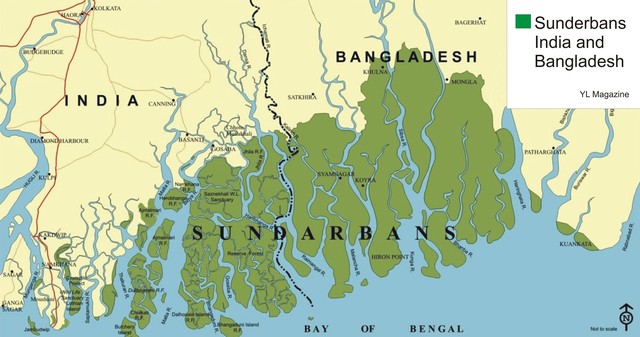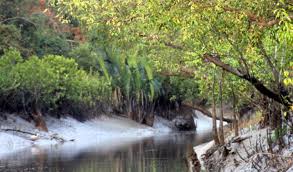 The Sundarbans, a UNESCO World Heritage Site, is located at the South eastern tip of the 24 Parganas district, about 110 km from Kolkata. It got its name from one of the mangrove plants known as Sundari (Heritiera Minor).
The Sundarbans, a UNESCO World Heritage Site, is located at the South eastern tip of the 24 Parganas district, about 110 km from Kolkata. It got its name from one of the mangrove plants known as Sundari (Heritiera Minor).
Sundarbans is part of the world’s largest delta, formed by the mighty rivers Ganga, Brahmaputra and Meghna. Situated on the lower end of Gangetic West Bengal, the Sundarbans is criss-crossed by hundreds of creeks and tributaries. It is one of the most attractive and alluring places remaining on earth, a truly undiscovered paradise.
It is the largest single block of tidal, halophytic mangrove forests in the world. The name can be literally translated as beautiful jungle. The name may have been derived from the Sundari trees that are found in the Sundarbans. . It spans a vast area covering 4264 sq. km in India alone. It is the largest Tiger Reserve and National Park.
Apart from being a unique largest mangrove eco-system of the world, the Sundarbans has the world’s largest deltaic mangrove forests and is also home to one of India’s most iconic wildlife species – the Royal Bengal Tiger. It is also the world’s largest estuarine forest criss-crossed by hundreds of creeks and tributaries, intersected by a network of tidal waterways, small islands of salt-tolerant mangrove forests and mudflats.
The interconnected network of waterways makes almost every nook and corner of the forest accessible by boats or rafts making it one of the most attractive and alluring places on earth and an undiscovered paradise. The Sundarbans also serves as a crucial protective barrier for the inhabitants in and around Kolkata against the floods that result from the cyclones which are a regular occurrence. Sundarbans has also been enlisted amongst the finalists in the New 7 Wonders of Nature.
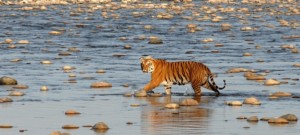 Attractions & Activities
Attractions & Activities
SUNDARBANS NATIONAL PARK: The most unique part of Sundarbans relates to the fact that it is the largest mangrove forest in the world with a large concentration of Royal Bengal Tigers. Some 78 species of mangroves are recorded across the forest. It also plays a vital role in the survival of marine organisms as it works as a wetland nursery to them.
The pride of West Bengal, Sundarbans covers an area of around 10,000km in the delta of Ganges. It lies on the south-east of Kolkata and borders the Bay of Bengal. This wonderful biosphere reserve houses many rare and endangered animals including aquatic mammals, tigers, birds and reptiles. Sundarbans is mainly located at the confluence of Ganga and Brahmaputra basin in between India and Bangladesh.
WILDLIFE: The Sunderbans forest is home to more than 250 tigers. The Royal Bengal Tigers have adapted themselves very well to the saline and aqua environs and are extremely good swimmers. As you enter the adventurous wild land of the Sunderbans, you will be thrilled to see the chital deer and rhesus monkey. The aqua fauna of Sunderbans include a variety of fish, red fiddler crabs, and hermit crabs.
Crocodiles can be seen along the mud banks. Sunderbans National Park is also noted for its conservation of the Ridley Sea Turtle. An incredible variety of reptiles is also found here, including king cobra, the rock python and the water monitor. The endangered river terrapin, Batagur baska, is found on the Mechua Beach, while barking deer are found only on Haliday Island in the Sunderbans.
SAJNEKHALI WATCH TOWER: Sajnekhali Watch Tower is counted among the most renowned watch towers in the park. The reason behind its popularity is its close proximity to a number of resorts in the Sunderbans area. This place also serves as the head office of the forest department. A tourist can obtain the permission to enter the national park from this spot only.
The watch tower can accommodate 20 people at a time. The major attractions in this region are Bono Bini Temple, Mangrove Interpretation Center and the tourist lodge of the Bengal Tourism Department. This watch tower makes exploring the wilderness fun and easy. Especially, the bird lovers get a special spectacle of avifauna species such as Pelican, Kingfishers, Plovers, Lap Wings, White Bellied Sea Eagle, Whimbrel, Curfews, and Sandpipers.
BHAGABATPUR CROCODILE SANCTUARY: The Bhagabatpur Crocodile Project in the Sundarbans has, of late, emerged as an important tourist destination of the Sundarbans. It is located adjacent to the Lothian Island and on the bank of the Saptamukhi Estuary. The dense mangrove forest at the confluence of Saptamukhi river system has great natural beauty to attract tourists all through the year. This hatchery of estuarine crocodile and Batagur Baska species of tortoises in the project has crocodiles of varying ages. Though this place is easily accessible through Namkhana, one can also visit it from Sajnekhali.
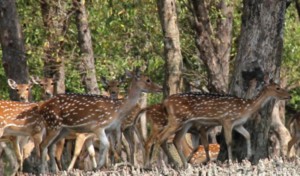
BURIRDABRI WATCH TOWER: This watch Tower in the Burirdabri camp is famous for its watchtower, a mud walk and mangrove cage trail leading to a view point known as Raimongal View Point. The ground fauna consisting of snails, varieties of crabs and mollusks can be observed closely during the mud walk.
The layout of this watchtower is very beautiful with one walking over wooden bridges and then through the mud cage and finally culminating to a wooden watch tower overlooking Bangladesh with the river Raimongal forming the international boundary between India and Bangladesh. One can see the Bangladesh Sundarbans from this watchtower. It has a capacity to host 10 persons at a time.
NETIDHOPANI: This is another watchtower in the series of several watch towers and is associated with the legend of Behula and Lakhindari. Today this watchtower offers a view of the ruins of a 400 year old Shiva Temple. It is also believed that there is a road on the extreme right of the forest which was built by King Pratapaditya to guard the coastal area. It is now covered with earth. There is also a sweet water pond. This watch tower has a capacity to host 20 persons at a time.
HALIDAY ISLAND WILDLIFE SANCTUARY: The Haliday Island Wildlife Sanctuary (also just known as the Haliday Wildlife Sanctuary) is approximately six square kilometers in size. It is a part of the Sundarbans Biosphere Reserve with the Sundarbans region as a whole becoming a Biosphere Reserve officially in 1989. The wildlife-heavy areas there are regarded as an environmentally-minded tourist destination.
KALASHDEEP: Kalash Island, in South 24 Parganas, is a part of the Sundarbans National Park that lies at the estuary of the River Matla. Being outside the core area of Sundarbans, visitors with armed guards are permitted to get down on the beach. During winters, it is the breeding ground of the Olive Ridley Turtles that arrive in great numbers on this beach for nesting. Kalash Island is also the home to many varieties of coastal birds and is specially a good place to spot uncommon waders. The Great Stone-curlew or Great Thick-knee (Esacus recurvirostris) is sighted on the beach.
HENRY ISLAND: Henry Island is named after a European who surveyed land in the area in the late 19th century. Have a look at the view from the watch tower in Bakkhali and do walk to the beach. The walk goes through a stretch of mangrove jungle accessed by crossing a small bamboo bridge. The fisheries department has dug more than 50 ponds occupying over 25 bigha on 100-hectares of land. Trees such as gora, kankru, palm, naturally growing sundari and hetal have been planted.
BAKKHALI: Bakkhali is located on one of the many deltaic islands spread across southern Bengal. Most of the islands are part of the Sundarbans, barring a few at the fringes. Some of these are joined together with bridges over narrow creeks. This small island juts out into the vast expanse of the Bay of Bengal. The south facing crescent shaped beach of Bakkhali is one of the rare ones in the world that offer great views of both sunrise and sunset.
There is an 8 km long beach stretching from Bakkhali to Frazergunj with gently rolling waves. These are twin towns now forming one continuous locality. Except on an occasional holiday the beach is not crowded. A small stretch near Bakkhali has been lighted up. It is a hard beach suitable for cycling or even driving. One can take long walks with coconut water. Bakkhali is also the name of a river in the Chittagong division of Bangladesh.
FRASERGANJ: Just 2 km north of Bakkhali is the twin town Fraserganj, which is named after Andrew Fraser. Fraser, in early 1900s, tried to build the area into a resort, which he couldn’t as the waves frequently washed the constructions. His office ruins can still be seen here. A Wind Energy Farm that generates 1 MW and is soon going to be extended to produce 2 MW is located in Fraserganj.
Best time to visit
September to March are the best months to visit Sundarbans, the winters being the most pleasant period in the area. Summers could be quite hot and send the temperature shooting up, but are an ideal time to visit the wildlife sanctuary. The monsoons with full generosity in showers may make travelling a little difficult but the lush green surroundings might just make up for it.
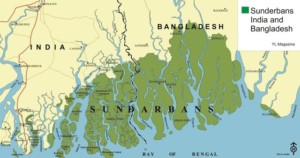 How to Reach
How to Reach
By Air: The nearest airport is the Netaji Subhash Chandra Bose Airport at Kolkata. From there one can make a road journey and after that a boat ride to reach Sundarbans.
By Train: Local trains to Canning are available from Sealdah (South) at regular intervals. Local shared vans are available from Canning to Godhkhali Jetty, the starting point of boat journey to the Sundabans.
By Road: Sundarbans is well connected with Kolkata. Road transportation is also available from Kolkata for Namkhana, Sonakhali, Raidighi, Canning, and Najat, which are all near the Sunderbans and have access to the riverine waterways.

